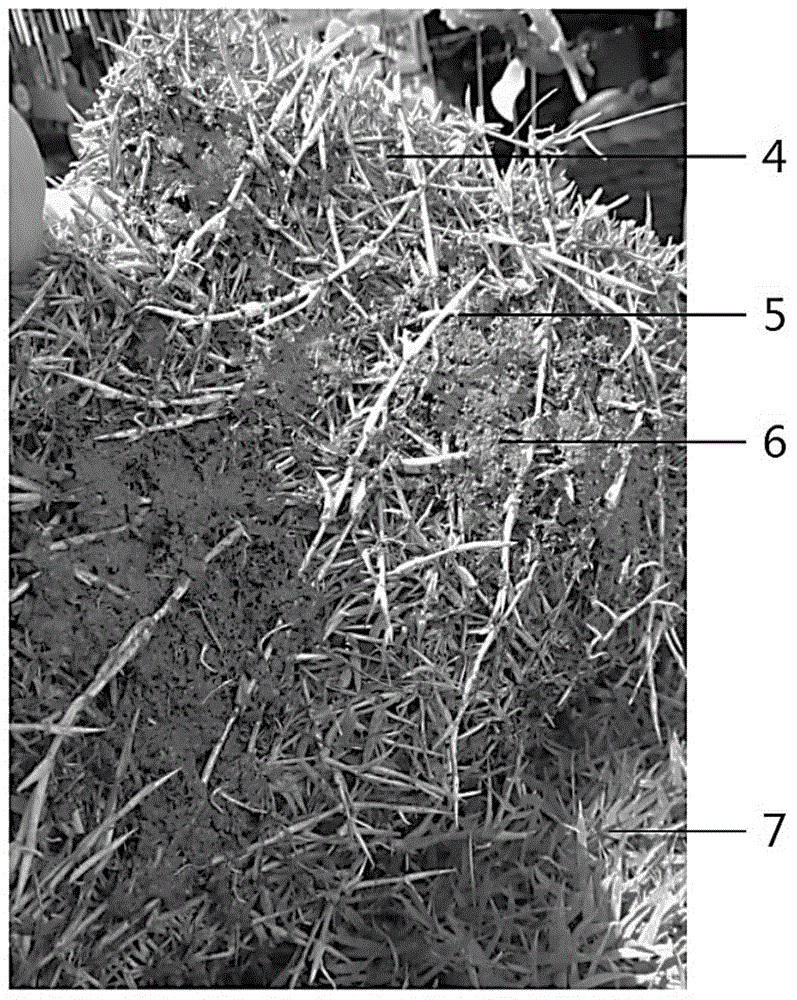Production method for pure turf without culture substrate
A technology without cultivation substrates and production methods, applied in the field of plant cultivation, can solve problems such as complexity, high requirements for cultivation conditions, and impossibility of application, and achieve the effects of avoiding negative effects and saving transportation costs
- Summary
- Abstract
- Description
- Claims
- Application Information
AI Technical Summary
Problems solved by technology
Method used
Image
Examples
Embodiment 1
[0033] Production method of hybrid Bermuda pure turf:
[0034] The turf production base is the original rice-planting farmland. After 2 repeated operations of rotary tillage, scraping and rolling, the firmness of the lawn bed soil has reached 87%, and the flatness error has been controlled to about 8mm. Open ditches and release water for irrigation for 24 hours. After the lawn bed has completely absorbed the water, drain the accumulated water on the surface.
[0035] Cut the stolons of hybrid Bermuda (species TIFDWARF) into 3-5 cm long grass stems, and spread them manually on the lawn bed soil that has been compacted and leveled and absorbs enough water. The amount of grass stems per square meter is about 0.5 kg, and the grass stems were spread as evenly as possible. Immediately after planting the grass stems, use a roller to press the grass stems into the soil on the surface of the lawn bed.
[0036]Immediately after planting the grass stems, ditch the ditch and release wat...
Embodiment 2
[0041] The production method of pure turf of false thrift grass:
[0042] Select the farmland where rice was originally planted, and through repeated operations of rotary tillage, scraping and rolling twice, the firmness of the bed soil has reached 90%, and the flatness error has been controlled to about 8mm. Open ditches and release water for irrigation for 24 hours. After the lawn bed has completely absorbed the water, drain the accumulated water on the surface.
[0043] Cut the stolons of False Thrift Grass (the variety is commoner) into 5-10cm long grass stems, each grass stem has more than 3 buds; manually plant the grass stems into the lawn bed soil that has absorbed enough water, and the grass stems More than 50% of the stems are buried in the soil, and the part exposed to the ground contains at least one bud; the distance between planting holes is controlled at 15-20cm.
[0044] After the grass stems are planted, immediately ditch the water to keep the lawn bed soil m...
Embodiment 3
[0048] Production method of bluegrass pure grass turf:
[0049] Choose a relatively flat farmland, irrigate until the soil moisture content is in the range of 15-20%, and repeat the operations of rotary tillage, scraping and rolling twice, and the firmness of the bed soil will reach 85%, and the flatness error will be controlled to about 8mm . Ditch the water for 24 hours. After the lawn bed has completely absorbed the water, drain the accumulated water on the surface.
[0050] Use a seeder to evenly sow the seeds of bluegrass bluegrass on the flat bed soil that has been compacted and leveled and absorbs enough water. The amount of seeds per square meter is 20 grams. Immediately after sowing, use a road roller to press the seeds into the lawn bed in the surface soil.
[0051] Immediately after the sowing is completed, ditch the water and irrigate immediately to keep the bed soil moist, and the thickness of the surface water is controlled at about 2mm. After planting for 20 d...
PUM
 Login to View More
Login to View More Abstract
Description
Claims
Application Information
 Login to View More
Login to View More - R&D
- Intellectual Property
- Life Sciences
- Materials
- Tech Scout
- Unparalleled Data Quality
- Higher Quality Content
- 60% Fewer Hallucinations
Browse by: Latest US Patents, China's latest patents, Technical Efficacy Thesaurus, Application Domain, Technology Topic, Popular Technical Reports.
© 2025 PatSnap. All rights reserved.Legal|Privacy policy|Modern Slavery Act Transparency Statement|Sitemap|About US| Contact US: help@patsnap.com


